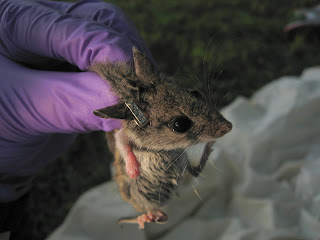One of the fun things about field work, besides collecting data for that wily thing called a dissertation, is all the things you see that you’re not studying. Because a lot of what I do is live-trap small animals, we often find things we’re not really looking for in the traps. The two small mammals that we are intentionally trying to catch are mice (Peromyscus) and voles (Microtus). We bait the traps with a peanut butter snack called Bamba, something that is very common in Israel, but not here. Hadas, a former IU post-doc who I collaborated with, used them during her PhD in Israel and has converted me to use them in my trapping. They are the perfect size for the traps and aren’t messy like peanut butter and oatmeal balls (what we used before).
The tasty treat seems to attract more than just mice and voles! We find an array of insects, spiders and other invertebrates in the traps. Ants have made nests in the traps (not a fan of this), crickets, grasshoppers, and cockroaches like hanging out in there. Snails and slugs like the outsides of the trap, I think because the metal stays cool during the night. Sometimes we even find long, slinky millipedes.
We find some interesting vertebrates too. Box turtles are common in both the open and forested parts of our sites (we usually almost step on them while walking the grids). They make a great “sucking” sound as they close the flap between their front legs and bring their head into the shell. (no pictures now, but will add soon) I often have to slalom down the road to avoid one taking its time crossing.
Normal turtle above, scared turtle below.
Normal turtle above, scared turtle below.
Last week we got two unexpected visitors to our traps. After collecting all traps that had animals in them in the morning, I was peaking in each to see if it had a new or recaptured (with ear tag) individual. I was startled when I looked in one trap and said to my field assistant, “Um, this is a toad.” Toads can look kind of like mice when they’re huddled in the back of the trap (I did the same thing last field season). He probably liked Bamba as much as the rodents!
The second surprise was a chipmunk. I was just talking with my friend, who also studies mammals, about how I’ve always wanted to catch one because they are so cute. My field assistant wasn’t sure if it was totally a good idea to handle the chipmunk, but I was going to try! I put on some thicker leather gloves (in case it was more bitey than the smaller rodents we’re used to) and got a hold of it the same way I do with the other rodents. It was not happy at first, but calmed down quickly. I noticed it had 3 ticks on it’s neck, and while holding it in one hand I got out the forceps and vials I needed to collect them. They can’t really go into our study, but I was still curious to see what kinds of ticks use chipmunks as their hosts.
We get to know some other animals that I consider more pests than interesting, but that’s for another time. Finding these fun other animals makes an early morning or hot afternoon a little more exiting or fun.












